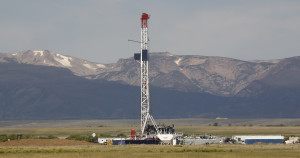We have much more to do and your continued support is needed now more than ever.
Clean Power Plan Heightens Need for Methane Regulations
The Obama Administration took historic action to combat climate change with the release of their Clean Power Plan on June 2nd, 2014. This important plan establishes first-ever limits on the amount of carbon pollution our nation’s power plants can dump into the atmosphere. The Plan is a strong first step in the right direction – however, because increased reliance on natural gas power plants is one of the main options states can use to comply, it is critical that we establish strict limits on methane pollution from the natural gas sector if the Plan is to deliver the intended climate benefits. If methane pollution from the natural gas sector goes unchecked, up to 36% of the climate benefits derived from the the Clean Power Plan may be undermined. [1]

Natural gas, often referred to as a “bridge fuel,” emits about half as much carbon pollution at the power plant than burning coal. However, natural gas systems also present challenges:
- Globally, natural gas systems leak between 2-4% of the gas produced.
- Methane is a powerful greenhouse gas – 86 times stronger than carbon dioxide over the short-term, which means a small amount of leakage can have a big effect on the climate.
- Analysis indicates that methane pollution leakage at levels above 3% is enough to negate the climate benefits of natural gas over coal. Uncertainty remains about exactly how much US natural gas systems leak methane pollution, but two studies published just last week found that some US natural gas fields may leak at rates well above the global average.
- Recent studies have shown that methane pollution may make natural gas just as bad for the climate as coal, and that EPA may be underestimating the amount of leakage.
Impacts on the Clean Power Plan
This all becomes even more concerning given that the Clean Power Plan, the most substantial action our country has taken to combat climate change, hinges largely on the climate benefits derived from switching to natural gas. Under the Clean Power Plan, the Environmental Protection Agency established the “best system of emission reductions” for limiting carbon pollution from the power sector. This “best system” is comprised of four building blocks:
- Heat rate improvements at existing coal plants;
- Increased use of existing efficient natural gas plants (to 70% of capacity);
- Increased use of low and zero-emitting energy sources;
- Increased end-use efficiency measures to reduce overall demand for energy.
EPA then crafted individual emission targets for each state by calculating the emission reductions achievable by applying each “building block” to the states’ 2012 baseline. When fully implemented, these state emission targets will deliver national emissions reductions of 26% below 2005 levels by 2020 and 30% below 2005 levels by 2030.
As noted above, one of four main ways EPA determined states can reduce their power sector-emissions is by increasing reliance on combined-cycle natural gas plants. Overall, 36% of the emission reductions calculated by EPA as part of the state targets comes from “re-dispatch” to the Natural Gas Combined Cycle Plants (“Building Block 2”).[1]
This means that if the recent studies are correct, and methane pollution from natural gas systems eliminates the climate benefit of natural gas over coal, more than one third of the reductions achieved by the Clean Power Plan would be eliminated.
Again, there is uncertainty around exactly how much natural gas leak methane pollution, and thus uncertainty as to whether or not the entirety of the climate benefit from the increased reliance on natural gas under the Plan would be eliminated – but we simply cannot afford to erode any of the climate benefit delivered by the Plan.
Even assuming full implementation, 26% below 2005 levels by 2020 is not quite as strong a reduction in power-sector emissions as the looming climate crisis warrants. To meet our own international commitments of reducing total national carbon emissions by 17% below 2005 levels, we must ensure the goals of the Clean Power Plan are strengthened, not eroded.

Cheap, Effective Solutions Exist
Luckily, there are cheap, effective solutions to reduce methane pollution that can help maintain the integrity of the climate goals of the Clean Power Plan and simultaneously safeguard wildlife and communities alike. In fact, states across the country have seen the damage wreaked on their lands and communities from unchecked methane pollution from natural gas wells, and have taken action:
- Colorado recently instituted the nation’s most comprehensive plan to clean up methane pollution from their natural gas sector;
- Ohio and Wyoming now both require natural gas drillers to conduct quarterly inspections to detect and fix leaks in their systems.
National Wildlife Federation is working with our affiliate organizations in states like New Mexico, Pennsylvania, New York, and West Virginia to support a comprehensive solution to reduce methane pollution from the natural gas industry across the country. As a federation dedicated to protecting wildlife and wildlife habitat nation-wide, we are fighting to combat climate change and preserve our country’s cherished outdoor heritage. Methane pollution from the natural gas sector is a threat on both these fronts, and must be addressed.
We applaud the EPA for the substantial action taken to combat climate change with the release of the Clean Power Plan. NWF looks forward to working hard alongside EPA and our affiliate partners in states across the country to ensure this standard stays strong through finalization and is robustly implemented by the states. However, it is critical that EPA take action to plug the methane pollution leaks around the country that, if left unchecked, will undermine the laudable goals of this important plan.
![]() Speak up in support of the Environmental Protection Agency’s Clean Power Plan to protect wildlife at risk from climate change.
Speak up in support of the Environmental Protection Agency’s Clean Power Plan to protect wildlife at risk from climate change.





















